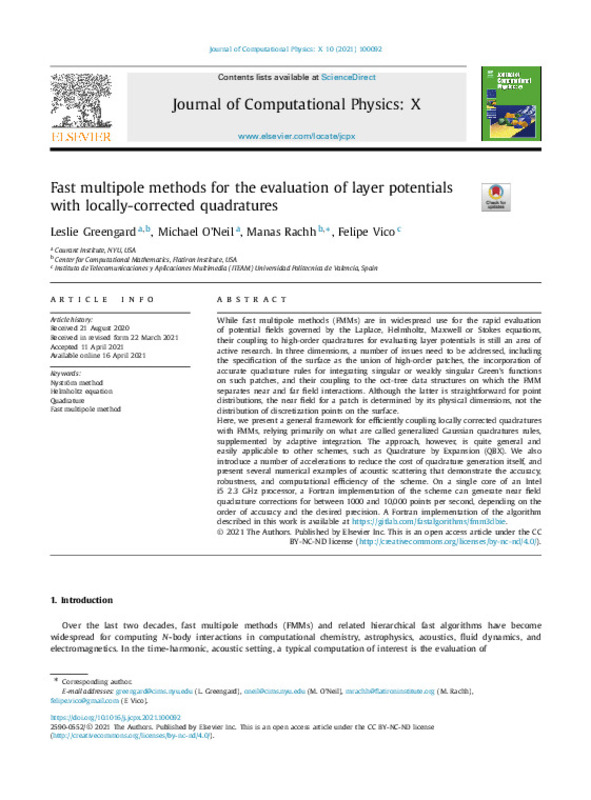|
Resumen:
|
[EN] While fast multipole methods (FMMs) are in widespread use for the rapid evaluation of potential fields governed by the Laplace, Helmholtz, Maxwell or Stokes equations, their coupling to high-order quadratures for ...[+]
[EN] While fast multipole methods (FMMs) are in widespread use for the rapid evaluation of potential fields governed by the Laplace, Helmholtz, Maxwell or Stokes equations, their coupling to high-order quadratures for evaluating layer potentials is still an area of active research. In three dimensions, a number of issues need to be addressed, including the specification of the surface as the union of high-order patches, the incorporation of accurate quadrature rules for integrating singular or weakly singular Green's functions on such patches, and their coupling to the oct-tree data structures on which the FMM separates near and far field interactions. Although the latter is straightforward for point distributions, the near field for a patch is determined by its physical dimensions, not the distribution of discretization points on the surface.
Here, we present a general framework for efficiently coupling locally corrected quadratures with FMMs, relying primarily on what are called generalized Gaussian quadratures rules, supplemented by adaptive integration. The approach, however, is quite general and easily applicable to other schemes, such as Quadrature by Expansion (QBX). We also introduce a number of accelerations to reduce the cost of quadrature generation itself, and present several numerical examples of acoustic scattering that demonstrate the accuracy, robustness, and computational efficiency of the scheme. On a single core of an Intel i5 2.3 GHz processor, a Fortran implementation of the scheme can generate near field quadrature corrections for between 1000 and 10,000 points per second, depending on the order of accuracy and the desired precision. A Fortran implementation of the algorithm described in this work is available at https://gitlab.com/fastalgorithms/fmm3dbie.
[-]
|
|
Agradecimientos:
|
We would like to thank Alex Barnett and Lise-Marie Imbert-Gérard for many useful discussions, and Jim Bremer and Zydrunas Gimbutas for sharing several useful quadrature codes. We also gratefully acknowledge the support of ...[+]
We would like to thank Alex Barnett and Lise-Marie Imbert-Gérard for many useful discussions, and Jim Bremer and Zydrunas Gimbutas for sharing several useful quadrature codes. We also gratefully acknowledge the support of the NVIDIA Corporation with the donation of a Quadro P6000, used for some of the visualizations presented in this research. L.
Greengard was supported in part by the Office of Naval Research under award number #N00014-18-1-2307. M. O¿Neil
was supported in part by the Office of Naval Research under award numbers #N00014-17-1-2059, #N00014-17-1-2451,
and #N00014-18-1-2307. F. Vico was supported in part by the Office of Naval Research under award number #N00014-
18-2307, the Generalitat Valenciana under award number AICO/2019/018, and by the Spanish Ministry of Science and
Innovation (Ministerio Ciencia e Innovación) under award number PID2019-107885GB-C32. We would also like to thank
the anonymous referees for many helpful comments that led to a much-improved manuscript
[-]
|









